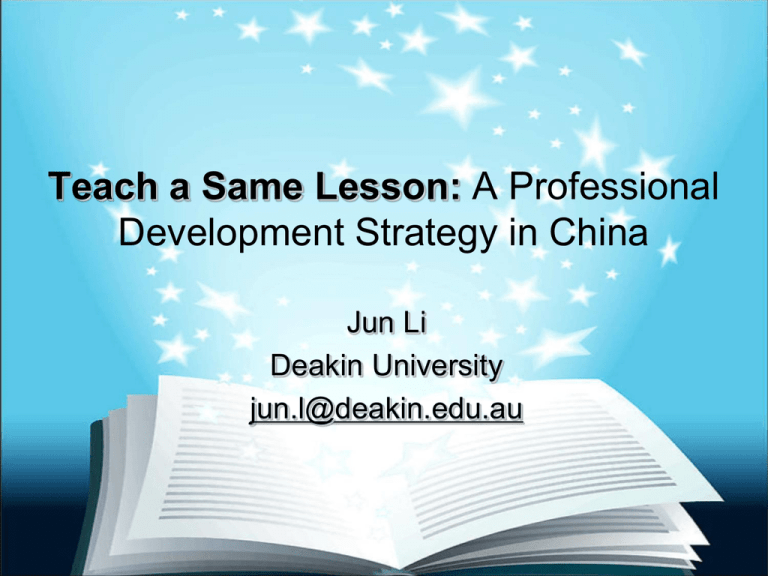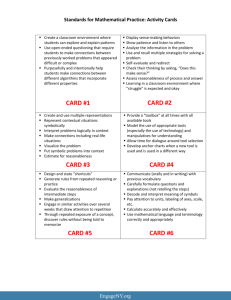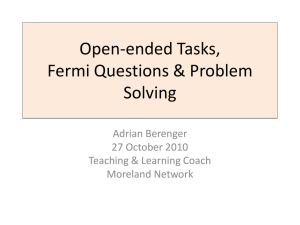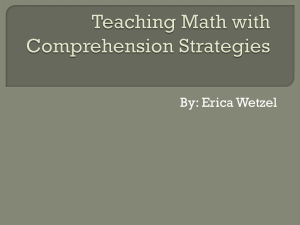1 Teach a Same Lesson
advertisement

Teach a Same Lesson: A Professional Development Strategy in China Jun Li Deakin University jun.l@deakin.edu.au The amount and percentage of school teachers in 2010 5.62 million Primary school teachers work in 257.4 thousand schools 53% In Guangzhou: 413 schools 355,300 students 4480 math teachers 1.52 million Senior high school teachers work in 28.6 thousand schools 14% 33% 3.53 million Junior high school teachers work in 54.9 thousand schools Teach a same lesson is a popular collaborative teaching research activity High School Young Mathematics Teachers’ Exemplary Lesson Demonstration Contests in Jiangsu Province, 2007 Winners of the teaching contest “A mathematical task is defined as a classroom activity, the purpose of which is to focus students’ attention on a particular mathematical idea. An activity is not classified as a different or new task unless the underlying mathematical idea toward which the activity is oriented changes” (Stein etc, 1996, p.460) Figure 1: Temporal phases of curriculum use (Stein, Remillard and Smith, 2007) Research Questions: 1. From written curriculum to intended curriculum, what and how tasks were kept, adapted, replaced or ignored by the teachers? 2. From intended curriculum to enacted curriculum, to what extent do the tasks as implemented remain consistent with the ways in which they were set up? Task features • with/without real-life context • single/multiple representations • open-ended/not open-ended • single/multiple solution strategies Task cognitive demands • memorization lower-level • procedures without connections • procedures with connections tasks higher-level • doing mathematics Lesson Topic: Average Rates of Change Level: Grade 11 Data sources: •3 first prize-winning videotaped lessons •Written “lesson explaining” •e-resources used in teaching •Teaching plan •Textbook & Teacher’s Manual Textbook Pages (p.5,6,7) Sudden Temperature Increase Task Can you describe the sudden temperature increase in the last two days by a mathematical model? Task features: • with real-life context; • multiple representations; • not open-ended; • single solution strategies Doing mathematics Average rates of change • read the graph • make the connections between "the steepness of the graph" and "the speed of change" • as slope could be used to measure the steepness of a straight line, it is reasonable to use it as an approximate measure of the steepness of a curve Sudden Temperature Increase Task Task features: with real-life context; multiple representations; not open-ended; single solution strategies Can you describe the sudden temperature increase in the last two days by a mathematical model? procedures with connections T: Please turn to page 4 and read the question on your textbook. T: Finished? Okay. Look at the big screen. The temperature increased 15.1°C from March 18 to April 18, but increase 14.8°C suddenly from April 18 to April 20. …… Doing mathematics Average rates of change S: The temperature rose rapidly in the second time period. So… T: (interrupt) You said that the temperature rose rapidly, why? Shall we calculate the temperature change from April 18 to April 20? Come on, you tell me the answer together. How many? …… Results: From written curriculum to intended curriculum 35 30 25 Teacher C Teacher B Teacher A Textbook 20 15 10 5 real-life context representations answers single multiple not open-ended open-ended single multiple without with 0 solution strategies • • • • Great expectations of students Using realistic context problems Discussing misconceptions with students Connecting and making use of previous knowledge and multiple representations Results From intended curriculum to enacted curriculum Some topics could be used for elicit further reflection on the three lessons • To form the concept of average rates of change is the important point of this lesson. Besides of the concept slope, what other previous knowledge could be connected? What is the big idea we should highlight in this lesson? What is your way of deepening students’ thinking beyond calculation? What we can learn from the three teachers? • There are two difficulties in teaching of this lesson. One is related to mathematics, i.e., how to help students find out that we could use the slope of the secant line to measure the steepness of a curve. The other is related to motivation, i.e., how to engage students and capture their interest in learning the formula? What is your way to deal with them? What we can learn from the three teachers? Processes associated with the decline of high-level cognitive demands (Stein, Remillard and Smith, 2007) Processes associated with the maintenance of high-level cognitive demands Discussion • Direct instruction by teacher combined with frequent teacher questioning --- a dominant teaching strategy used in China • “Teach a same lesson” is embedded in the Chinese teaching culture 1.Changes in teacher knowledge and belief Lecture-oriented model:1 →2 →3 Practice-oriented model:2 →3 →1 3. 2. Changes Changes in student learning in teachers’ behavioural patterns in classroom outcomes teaching











